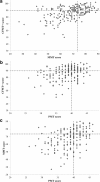Applied screening tests for the detection of superior face recognition
- PMID: 30009252
- PMCID: PMC6019417
- DOI: 10.1186/s41235-018-0116-5
Applied screening tests for the detection of superior face recognition
Abstract
In recent years there has been growing interest in the identification of people with superior face recognition skills, for both theoretical and applied investigations. These individuals have mostly been identified via their performance on a single attempt at a tightly controlled test of face memory-the long form of the Cambridge Face Memory Test (CFMT+). The consistency of their skills over a range of tests, particularly those replicating more applied policing scenarios, has yet to be examined systematically. The current investigation screened 200 people who believed they have superior face recognition skills, using the CFMT+ and three new, more applied tests (measuring face memory, face matching and composite-face identification in a crowd). Of the sample, 59.5% showed at least some consistency in superior face recognition performance, although only five individuals outperformed controls on overall indices of target-present and target-absent trials. Only one participant outperformed controls on the Crowds test, suggesting that some applied face recognition tasks require very specific skills. In conclusion, future screening protocols need to be suitably thorough to test for consistency in performance, and to allow different types of superior performer to be detected from the outset. Screening for optimal performers may sometimes need to directly replicate the task in question, taking into account target-present and target-absent performance. Self-selection alone is not a reliable means of identifying those at the top end of the face recognition spectrum.
Keywords: Composite face-processing; Face recognition; Individual differences; Super recognisers.
Conflict of interest statement
Ethical approval for the study was granted by Bournemouth University’s Ethics Committee. Informed consent to participate was provided by all participants.Consent to publish was obtained from all participants.The authors declare that they have no competing interests.Springer Nature remains neutral with regard to jurisdictional claims in published maps and institutional affiliations.
Figures








References
-
- Bate, S., Adams, A., Bennetts, R., & Line, H. (in press). Developmental prosopagnosia with concurrent topographical disorientation: A case report and virtual reality training programme. Neuropsychological Rehabilitation. 10.1080/09602011.2017.1409640 - PubMed
LinkOut - more resources
Full Text Sources
Other Literature Sources
